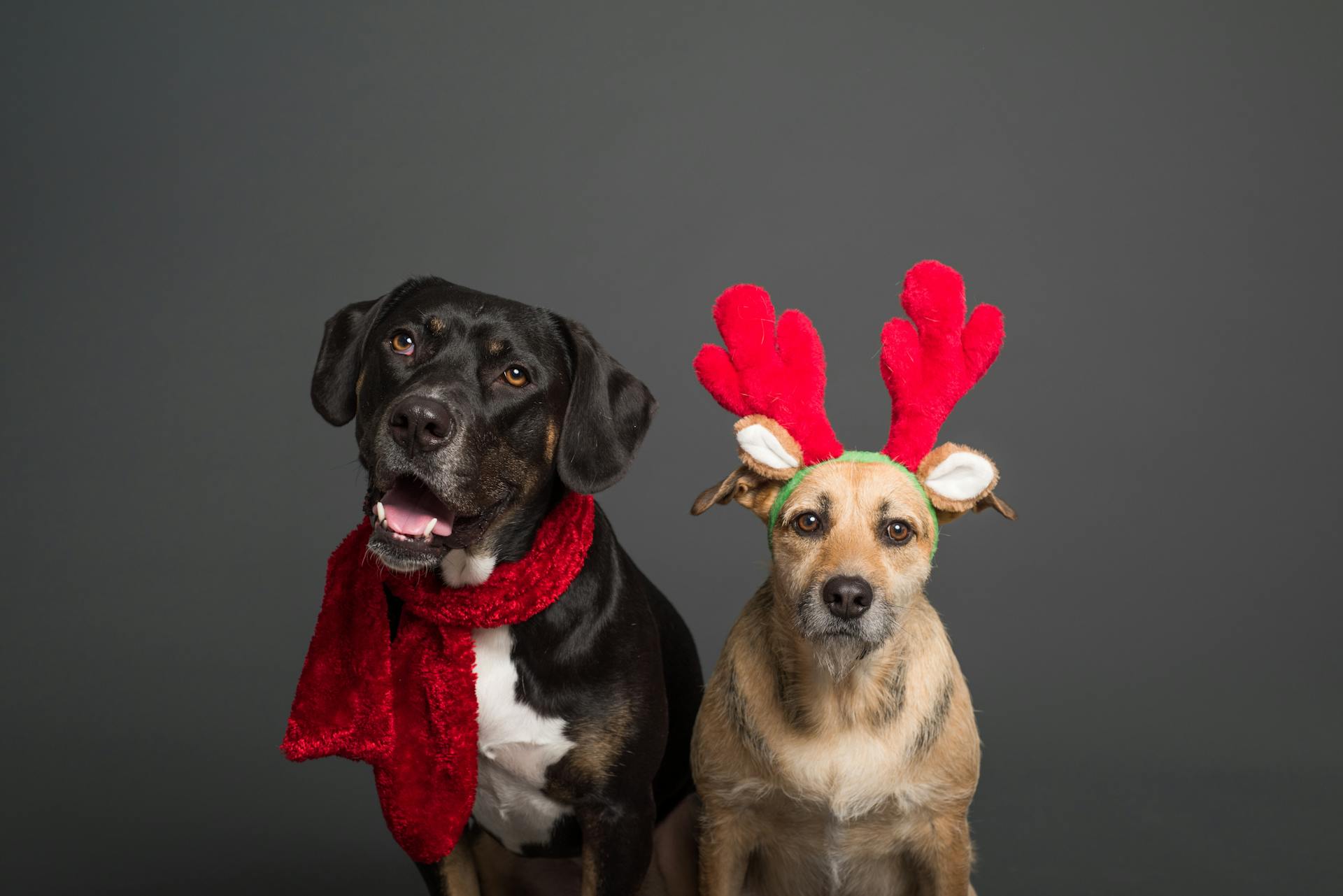
Knowing what kind of dog you have can be a game-changer, especially when it comes to their behavior and needs. Determining your dog's breed or mix of breeds can help you understand their unique characteristics.
Their size, coat type, and energy level are just a few factors that can vary greatly between breeds. For example, a small, fluffy dog like a Poodle requires regular grooming, while a larger dog like a Labrador Retriever needs plenty of exercise.
Understanding your dog's breed or mix can also help you anticipate potential health issues. Some breeds are prone to specific health problems, such as hip dysplasia in larger breeds or eye problems in smaller breeds.
Determining Your Dog's Breed Identifying Breed 101
Determining your dog's breed can be a fun and rewarding experience, but it's not always easy. Physical traits are a good place to start, as they can provide clues about your dog's ancestry. Faculty and students from the Shelter Medicine Program at the University of Florida College of Veterinary Medicine conducted a national survey of dog experts to compare their best guesses for the breeds of dogs in a series of photographs.
To identify your dog's breed, make a list of their notable physical characteristics, such as head shape and muzzle length, ear shape and carriage, tail shape and carriage, body build and size, and coat texture, color, length, and pattern. Prioritize clues in your dog's shape (morphology) over their color or coat type because the former are a better reflection of their total ancestry.
Here are some examples of physical characteristics that can help identify your dog's breed:
- A heavily boned and blocky head is common for guard dog breeds.
- A long and narrow nose may indicate a Collie, German Shepherd, Dachshund, or Doberman.
- A curly tail may suggest an ancient breed, although there are exceptions.
- High-set ears likely rule out sporting breeds like Labradors.
- Enlarged ears may indicate hounds or sporting breeds like spaniels or retrievers.
In addition to physical characteristics, behavioral traits can also provide clues about your dog's breed. For example, dogs bred for protection, like Rottweilers and Doberman Pinschers, tend to be cautious around strangers and may be protective of their families. Dogs bred for herding, like Border Collies and Australian Shepherds, may be seen "herding" small children and other pets in the home.
To determine your dog's breed, write down their defining characteristics, such as weight, height, and build. You should also make observations about the length and type of their fur, the color of their hair and eyes, and the shape of their ears. Then, use these clues to search for breeds on the American Kennel Club website or other breed description guides. Keep in mind that this method won't be as reliable as a DNA test or taking your dog to a vet.
Why Identify Your Dog's Breed
Identifying your dog's breed can be beneficial for delivering tailored care. Understanding your dog's breed can help you know how much exercise they need, what toys they'll enjoy, and what environment they'll thrive in.
A dog's breed can also affect their health. For example, dogs with deep, narrow chests, like Irish Setters or Great Danes, may be more prone to bloat, a condition that can be life-threatening if left untreated.
Knowing your dog's breed can also help you identify potential health issues that may arise. For instance, breeds like the Labrador Retriever and Scottish Terrier are often predisposed to allergic skin conditions.
If you're a pet parent to a mixed-breed dog, understanding your dog's breed can be especially important. Even if your veterinarian or shelter staff can offer ideas about your pup's ancestry, it's still possible to misidentify your dog's breed by visual cues alone - experts misidentify a dog's breed about 75% of the time.
Here are some key health issues to consider based on your dog's breed:
By knowing your dog's breed, you can take steps to reduce the likelihood of these health issues and provide the best possible care for your furry friend.
Identification Methods
You can try a few different methods to figure out what kind of dog you have. One way is to write down your dog's defining characteristics, such as its weight, height, and build. You should also make observations about the length and type of your dog's fur, the color of its hair and eyes, and the shape of its ears.
To make this process easier, you can use a list to note down your dog's characteristics. Here are some key points to consider:
- Weight and height: Record your dog's weight and height to help narrow down the possibilities.
- Build: Note whether your dog is large, medium, or small-framed, and whether it has a deep chest or is more muscular or slender in build.
- Fur: Make note of the length, type, and texture of your dog's fur.
- Color: Record the color of your dog's fur, including any patterns or markings.
- Ears: Note the shape and size of your dog's ears.
By writing down these characteristics, you can use them to search for breeds on the American Kennel Club website or take a dog breed identification quiz. Keep in mind that these methods may not be as reliable as a DNA test or taking your dog to a vet, but they can still give you a good idea of what kind of dog you have.
Physical Traits for Identification
Physical traits can be a great starting point for identifying a dog's breed. By observing your dog's physical characteristics, you can make an educated guess about their breed makeup.
A dog's weight and height can be a good starting point for identification. To determine your dog's weight, you can weigh yourself and then weigh yourself holding your dog. The difference between the two weights is the weight of your dog.
Make a list of your dog's notable physical characteristics, such as head and muzzle shape, ear shape and carriage, tail shape and carriage, body build and size, coat texture, color, length, and pattern. Prioritize clues in your dog's shape (morphology) over their color or coat type because the former are a better reflection of your dog's total ancestry.
Some physical characteristics that can help identify a dog's breed include:
* Head shape:
+ Heavily boned and blocky head: common for guard dog breeds

+ Long and narrow nose: Collie, German Shepherd, Dachshund, or Doberman might be likely
* Ear shape and size:
+ High-set ears: likely rules out a sporting breed like a Labrador Retriever
+ Enlarged ears: think hounds or sporting breeds (e.g., spaniels, retrievers, pointers, setters)
* Tail shape and carriage:
+ Curly tail: may mean an ancient breed, though there are exceptions (e.g., Pomeranian)
Genetic Testing
Genetic testing is the most accurate way to determine your dog's breed mix. This method looks at your dog's DNA to identify the presence of specific DNA sequences associated with certain breeds.
Companies like Wisdom Panel and Embark have tested thousands of dog samples to identify breed-specific DNA sequences. This allows them to accurately identify small genetic differences that are associated with specific breeds.
Most canine genetic testing providers claim to be over 95% accurate. However, no genetic test is perfect, and some false identifications can occur.
The size of the reference sample database is crucial for accurate results. A test with a larger database will have more reliable results, as it can compare the submitted genetic sample against a bigger pool of samples.

Wisdom Panel, for example, uses the largest dog breed database in the world to identify breeds that other services don't even test for. They screen for over 350 breeds, types, and varieties, and can identify breeds down to 1% of the mix.
Genetic testing can also report breed mix back three generations and test for health conditions and traits. This provides a more comprehensive understanding of your dog's lineage and can help you make informed decisions about their care.
Take a Quiz
Taking a dog breed identification quiz can be a fun and easy way to narrow down your dog's ancestry. Online quizzes ask a few simple questions about your dog's appearance and traits, and then give you a list of possible matches.
Quizzes rely on visual cues, so they might not get the ancestry 100% right, especially if your dog is a mix of several breeds. Still, they're a great way to get started.
You can try taking a quiz to see what breed or breeds your dog might be related to. For example, the "Dog Scanner" app predicted Koda was a mix of certain breeds.
Frequently Asked Questions
Is there an app to identify dog breeds?
Yes, the Dog Scanner app can identify dog breeds with over 100 recognized breeds listed, including those acknowledged by the FCI and AKC. Download the app to view detailed information and images of every breed.
Can Siri tell me what kind of dog I have?
Yes, Siri can identify your dog's breed with its "Look Up — Dog" feature, which provides two best guesses and images of similar-looking dogs. Tap the paw print icon next to the "Add a Caption" field to get started.
How do you tell what kind of dog your puppy will be?
To determine your puppy's breed, look for physical characteristics and observe their behavior, personality, and interactions with other dogs. By considering these factors, you can make an educated guess about your puppy's breed and learn more about their needs and traits.
Sources
- https://sheltermedicine.vetmed.ufl.edu/research/current-studies/dog-breed-identification/
- https://www.wisdompanel.com/en-us/blog/breed-identifier
- https://www.petsradar.com/advice/what-breed-is-my-dog-vets-guide
- https://www.wikihow.com/Determine-Your-Dog%27s-Breed
- https://www.noguiltmom.com/figure-dogs-breed/
Featured Images: pexels.com


